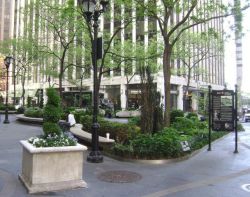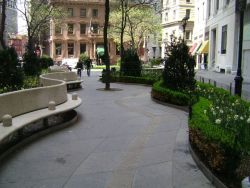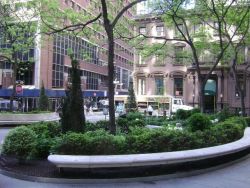The Queen Elizabeth II September 11th Garden
The Queen Elizabeth II September 11th Garden
What was here before?
Manhattan was once called Manahatta by the Lenape who lived here for thousands of years. Nearby Broadway was the start of the Mohican Trail that extended to what is now Montreal.
With the arrival of the Dutch, this site was part of a public street along the East River. By 1730 this area was known as Hanover Square in tribute to the House of Hanover, which started its reign with George I in 1714. For much of the 18th century, Hanover Square was the center of New York's printing trade and retail business.
The Great Fire of 1835 destroyed most of the buildings in the vicinity. The area was rebuilt as a commercial and financial center. The landmarked India House building (originally the Hanover Bank) is the only surviving example of the many Italianate banks erected in the financial district in the 1850s.
How did this site become a park?
This site was transferred to the parks department in 1951. Parts of Pearl Street were narrowed to make the borders we see today. The park was redesigned in the 1970s and one side of Hanover Square closed to commercial traffic. A 19th-century statue of New York Mayor Abraham De Peyster (1657–1728) was relocated here in 1976 and again moved in 2013 to Thomas Paine Park following this park’s conversion to the British Memorial Garden.
This garden was commissioned by the British Memorial Garden Trust and given to the City in memory of the 67 British and Commonwealth citizens who died on September 11, 2001.
The garden is based on a plan by English landscape designers Julian and Isabel Bannerman and combines the historic footprint of this public square with the silhouette of the British Isles. Master sculptor Simon Verity carved and engraved the undulating Morayshire sandstone inlay, quarried from the highlands of Scotland. The coping is inscribed with the shires of the British Isles—from Aberdeen in the north to Portland in the south. The large, rounded ‘Braemar’ stone, from a riverbed near Queen Elizabeth II’s home in Balmoral, sits in the garden’s south end, marking the distance from Aberdeen to New York.
Garden designers Lynden B. Miller and Ronda M. Brands worked with the Bannerman design to create an enduring garden for all seasons, selecting plants from both the British Isles and the North American landscape that echo the spirit of an English garden.
At the northern end, stand Two Canadian hemlocks which frame the inner path. Running the length of the garden is a ribbon of 67 heavenly bamboo shrubs, each signifying one of the 67 British victims of 9/11. Deep green spires of Graham Blandy boxwoods and Irish yew add depth and punctuation to the garden. Marking the southern entrance to the garden are two evergreen holly trees — a cultivar bred from an English holly parent.
Serpentine benches made of white Portland stone quarried in southern England and carved in Northern Ireland run through the garden, with a backdrop of yew shrubs.
A yellow magnolia, called Magnolia ‘Elizabeth’ rises at the southern end of the planting beds. HM Queen Elizabeth II, the garden’s namesake, visited this living memorial on July 6, 2010. The Magnolia ‘Elizabeth,’ patented at the Brooklyn Botanic Garden in 1977, was planted by her grandson HRH Prince Harry Duke of Sussex on May 29, 2009.
Who is this garden named for?
HM Queen Elizabeth II (1926-2022) was the Queen of the United Kingdom and of the Commonwealth Realms. She was the longest-reigning monarch in British history, serving 70 years of service spanning the tenures of 15 British prime ministers and 14 American presidents.
Check out your park's Vital Signs
Clean & Safe
Green & Resilient
Empowered & Engaged Users
Share your feedback or learn more about how this park is part of a
Vital Park System



